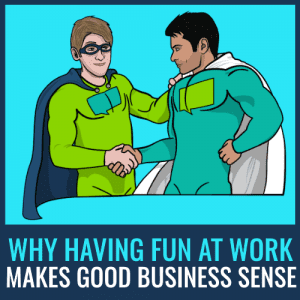 Having fun at work has a very different meaning today than it used to. In the dark and grey days of the past, people who dared to have fun at work were thought of as time-wasters or nogoodniks sitting around on their keisters and goofing off (people talked funny back in the day).
Having fun at work has a very different meaning today than it used to. In the dark and grey days of the past, people who dared to have fun at work were thought of as time-wasters or nogoodniks sitting around on their keisters and goofing off (people talked funny back in the day).
In the old days, there was a higher demand for manual labour and jobs that didn’t require much creativity. As automation took hold, the shape of the workforce evolved. Today, the world of work is changing at a faster rate than ever before. It doesn’t matter who the organisation is. The world is so interconnected that these changes affect every industry.
In the past, the employees who kept their heads down could machine more widgets with their lathes. The business with the highest number of productive employees could succeed against the competition. To be successful today, businesses need people who can think on their feet and come up with outside-the-box solutions.
What happened to creativity?
 As children, fun and play were the main vehicles of learning. It’s no coincidence that children tend to be more creative and use trial and error to figure out what works and what doesn’t. As we grow older, the pressures of society suppress this creative spark. Suddenly it’s not okay to come to school in a cardboard spacesuit.
As children, fun and play were the main vehicles of learning. It’s no coincidence that children tend to be more creative and use trial and error to figure out what works and what doesn’t. As we grow older, the pressures of society suppress this creative spark. Suddenly it’s not okay to come to school in a cardboard spacesuit.
Because we’re scared of embarrassing ourselves, we don’t exercise our creative muscles anymore. By the time we finish school and join the workforce, it takes much more courage to see things differently and lead the way with a left-field solution.
 Where does fun come into it?
Where does fun come into it?
Allowing fun at work creates an environment that encourages creative thinking. When people aren’t afraid to get things wrong, they’re more likely to find a more effective solution than anything in their training manuals. In this way, training managers can engage with their learners in a more productive way. By doing this, they can tailor their training programmes to suit the people taking part in them.
Tailoring the content means that the training will be more relevant, more meaningful and easier to retain. Injecting some fun into the training programme makes it more compelling for the learner, letting them complete more training in a shorter space of time. Every new hire costs a business $30k on average, with most of that coming from the loss in productivity as the new starter gets up to speed. With today’s job-hopping culture, speedy onboarding is a necessity.
What do your employees want?
I f you make the work environment more fun, though, you can effectively reduce this attrition rate. A workplace that encourages playfulness and experimentation can give today’s employees the things they are really looking for. A 2013 survey found that the biggest reason people like their jobs was because they enjoyed working with their colleagues. In the same survey, the employees valued freedom, autonomy, and flexibility in their jobs. Moreover, they appreciated managers who helped create an environment of openness.
f you make the work environment more fun, though, you can effectively reduce this attrition rate. A workplace that encourages playfulness and experimentation can give today’s employees the things they are really looking for. A 2013 survey found that the biggest reason people like their jobs was because they enjoyed working with their colleagues. In the same survey, the employees valued freedom, autonomy, and flexibility in their jobs. Moreover, they appreciated managers who helped create an environment of openness.
Meeting the needs of your employees means that you can retain more employees for longer, help them progress faster in their careers and create a culture of collaboration. With a stronger organisational culture, your people will clearly see the meaning behind their work and their place in the bigger picture.
Fun at work isn’t only about foosball tables and Funny-tie Friday – a fun working environment is one that lets everyone participate in the company’s direction. By making work more fun, you are making your teams more collaborative and you are giving your employees the permission to become the best they can be.
If that doesn’t make good business sense, then we don’t know what does!
Want to lead the way for behavioural change in your organisation? The first step is to create a training programme that engages your employees. Download our Engagement Engine Workbook to give your training an engagement audit!









